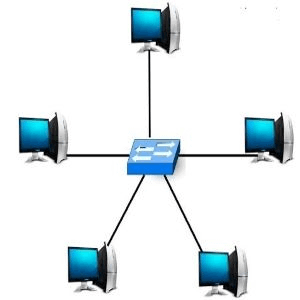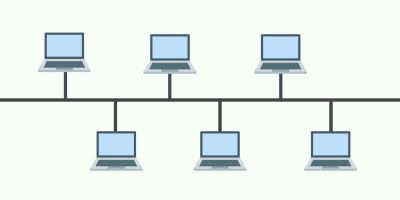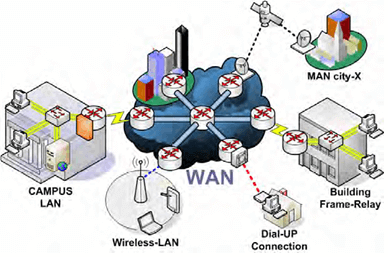Computer Network
A network set up by connecting two or more computers and other supporting hardware devices through communication channels is called a computer network. It enables computers to communicate with each other and to share commands, data, etc., including the hardware and software resources.
Uses of Computer Network:
- It allows you to share resources such as printers, scanners, etc.
- You can share expensive software and database among network users.
- It facilitates communications from one computer to another computer.
- It allows the exchange of data and information among users through a network.
Popular Computer Networks:
- Local Area Network (LAN)
- Metropolitan Area Network (MAN)
- Wide Area Network (WAN)
Local Area Network (LAN):
As the name suggests, the local area network is a computer network that operates in a small area, i.e., it connects computers in a small geographical area like within an office, company, school, or any other organization. So, it exists within a specific area, e.g. home network, office network, school network, etc.
A local area network may be a wired or wireless network or a combination of both. The devices in a LAN are generally connected using an Ethernet cable, which offers an interface to connect multiple devices like router, switches, and computers. For example, using a single router, few Ethernet cables, and computers, you can create a LAN at your home, office, etc. In this network, one computer may act as a server and other computers, which are part of the network, may serve as clients.
Topologies of LAN:
Topology: It refers to the arrangement of computers (nodes) in a computer network. The main topologies of a local area network are as follows:
Ring Topology:

As the name suggests, in a ring topology, the computers are connected in a circular and closed loop. The message in this topology moves only in one direction around the ring from one node to another node and is checked by each node for a matching destination address. So, the data keeps moving until it reaches its destination. All nodes are equal; a client-server relationship does not exist between them. As the nodes are in the form of a ring, if one node fails to transmit the data, the flow of communication is severed.
Star Topology:

In this topology, all the computers are separately connected to a central node or connection point, which can be a server, a hub, a router, or a switch. This topology offers an advantage that if a cable does not work, only the respective node will suffer, the rest of the nodes will work smoothly. All data or messages that one node sends to another passes through the central hub.
This topology is easy to design and implement as well as it is easy to add additional nodes to the central node. The major drawback of this topology is that it is prone to bottleneck or failure at the central connection point, i.e., failure at the central node will affect the entire communication.
Bus Topology:

In this arrangement, the nodes (computers) are connected through interface connectors to a single communication line (central cable) that carries the message in both the directions. The central cable to which all the nodes are connected is the backbone of the network. It is called a bus. The signal in this arrangement travels in both directions to all the machines until it finds the recipient machine. It is easy to set up than other topologies as it uses only a single central cable to establish the network.
Benefits of LAN:
- It offers a higher operating speed than WAN and MAN.
- It is less expensive and easy to install and maintain.
- It perfectly fulfills the requirement of a specific organization, such as an office, school, etc.
- It can be wired or wireless or a combination of both.
- It is more secure than other networks as it is a small set up that can be easily taken care of.
Primary Functions of LAN:
- Sharing of files: It allows you to share or transfer files from one computer to another computer within the LAN. For example, in a bank, it can be used to send a file with the details of transactions of a customer from the server to clients.
- Sharing of printers: It also allows shared access to a printer, file servers, etc. For example, ten computers that are connected through LAN can use a single printer, file server, fax machine, etc.
- Sharing of Computational capabilities: It allows the clients to access to the computational power of a server, e.g., an application server as some applications which run on clients in a LAN may require higher computational capabilities.
- Mail and message related services: It allows sending and receiving mails between computers of a LAN. You are required to have a mail server for this.
- Database services: It also allows storing and retrieving data with the help of a database server.
Metropolitan Area Network (MAN):

MAN is a high-speed network that spreads over a large geographical area such as a metro city or town. It is set up by connecting the local area networks using routers and local telephone exchange lines. It can be operated by a private company, or it may be a service provided by a company such as a local telephone company.
MAN is ideal for the people of a relatively large area who want to share data or information. It provides fast communication via high-speed carriers or transmission media such as copper, fiber optics, and microwaves. The commonly used protocols for MAN are X.25, Frame Relay, Asynchronous Transfer Mode (ATM), xDSL (Digital Subscriber Line), ISDN (Integrated Services Digital Network), ADSL (Asymmetrical Digital Subscriber Line), and more.
The area covered by MAN is larger than the LAN but smaller than a WAN. Its network ranges from 5 to 50 km. Furthermore, it also provides uplinks for connecting LANs to WANs and the internet. An organization can use a MAN to connect all of its LANs located at its different offices across the city.
Examples of MAN:
- Cable TV Network
- Telephone service provides that provide high-speed DSL lines
- IEEE 802.16 or WiMAX
- Connected fire stations in a city
- Connected branches of a school in a city
Advantages of MAN:
- Less Expensive: It is less expensive to set up a MAN and to connect it to a WAN.
- High Speed: The speed of data transfer is more than WAN.
- Local Emails: It can send local emails fast.
- Access to the Internet: It allows you to share your internet connection, and thus multiple users can have access to high-speed internet.
- Easy to set up: You can easily set up a MAN by connecting multiple LANs.
- High Security: It is more secure than WAN.
Wide Area Network (WAN):

WAN extends over a large geographical area. It is not confined within an office, school, city, or town and is mainly set up by telephone lines, fiber optic, or satellite links. It is mostly used by big organizations like banks and multinational companies to communicate with their branches and customers across the world. Although it is structurally similar to MAN, it is different from MAN in terms of its range, e.g., MAN covers up to 50 Kms, whereas WAM covers distances larger than 50 Km, e.g., 1000km or more.
A WAN works by using TCP/IP protocol in combination with networking devices such as switches, routers, firewalls, and modems. It does not connect individual computers; rather, they are designed to link small networks like LANs and MANs to create a large network. The internet is considered the largest WAN in the world as it connects various LANs and MANs through ISPs.
The computers are connected to the wide area network through public networks, such as telephone systems, leased lines or satellites. The users of a WAN do not own the network as it is a large setup connecting the remote computer systems. However, they are required to subscribe to a service provided by a telecommunication provider to use this network.
Advantages of a WAN:
- Large Network Range: It spans a large geographical area of 2000 km or more, e.g., from one country to another countries.
- Centralized data: It allows your different office branches to use your head office server for retrieving and sharing data. Thus, you don?t need to buy email servers, files server and back up servers, etc.
- Get updated files and data: It provides an ideal platform for companies who need a live server for their employees to exchange updated files within seconds.
- High bandwidth: It offers high bandwidth than a normal broadband connection. Thus, it can increase the productivity of your company by offering uninterrupted data transfer and communication.
- Workload Distribution: It helps distribute your workload to other locations. You can hire employees in different countries and assign them to work from your office.
Examples of WAN:
Internet
US defense department
Stock exchanges network
Railway reservation system
Big Banks’ cash dispensers’ network
Satellite systems
Visit for: Computer Network Tutorial
